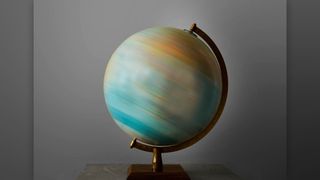Does a Hdd Continuously Spin or Does It Stop After a While
What would happen if Earth suddenly stopped spinning?

Earth is steadily spinning like a top, even if we can't see, touch, hear or feel it. So, what would happen if Earth were to abruptly stop rotating?
If the spinning were to stop, the angular momentum of every object on Earth would rip the surface apart, resulting in a really, really bad day.
"This is just a thought experiment," said James Zimbelman, senior geologist emeritus at the Smithsonian's National Air and Space Museum in Washington, D.C. "There is no natural force that would stop the Earth from spinning. That is part of why the planet has been spinning since it formed, which is pretty impressive."
Related: How fast does the Earth move?
Put a spin on it
Earth makes one complete rotation on its axis every 23 hours, 56 minutes and 4.09053 seconds. This translates to land at the equator moving at about 1,100 mph (1,770 km/h), with rotational velocity decreasing to zero at the poles, according to Zimbelman. If the planet were to come to an abrupt halt, the angular momentum imparted to the air, water and even rocks along the equator would keep moving at this speed of 1,100 mph. The movement would scour the surface while ripping it apart and sending shards into the upper regions of the atmosphere and outer space.
But what is angular momentum?
Let's take a step back. Linear momentum is the product of an object's mass and its velocity (direction and speed). A passenger in a moving car that stops abruptly will continue to move forward due to linear momentum. Ouch.
Angular momentum is a rotational analog to linear momentum. It is the product of the moment of inertia (the rotational force needed to rotate mass) and angular velocity. A quarterback imparts angular momentum to a football as it is heft through the air toward the wide receiver.
"One of the fundamentals of physics is the conservation of angular momentum," Zimbelman told Live Science. "Once something is spinning, you have to exert the same force [in the opposite direction] to stop it from spinning."
But all would not be not lost if the Earth were to stop spinning.
Regroup, reform, accrete
According to Zimbelman, the bits and pieces that broke away from the surface would regain some spin as Earth and its remnants continued on their path around the sun. Eventually, the planet's gravitational pull would draw the halo of fragments back with an unexpected effect.
"What [Isaac] Newton helped us figure out with classical mechanics is that the pieces accumulating and moving closer together would release some of their own energy, heating things up," Zimbelman said.
Think of it like a meteorite streaking across the sky. The remnants that ended up in the far reaches of the atmosphere and outer space would be drawn to the surface by the planet's gravitational pull, and they would release energy upon impact. The constant bombardment of these bits and pieces would liquefy the crust into a molten "ocean of rock," Zimbelman said. Eventually, colliding fragments would be reabsorbed into the molten sea through a process called accretion.
According to Zimbelman, the rapid and destructive transition would also vaporize most of the water on the planet's surface. While most of this vaporized water would be lost, some might be incorporated into newly solidified minerals, like olivine. Finally, not all of the fragments would be reabsorbed through accretion. Some of the planetary bits would be swept up by the moon's gravitational pull, bombarding the nearby satellite and creating countless more craters across its surface.
Originally published on Live Science.
Source: https://www.livescience.com/what-if-earth-stopped-spinning.html
0 Response to "Does a Hdd Continuously Spin or Does It Stop After a While"
Post a Comment